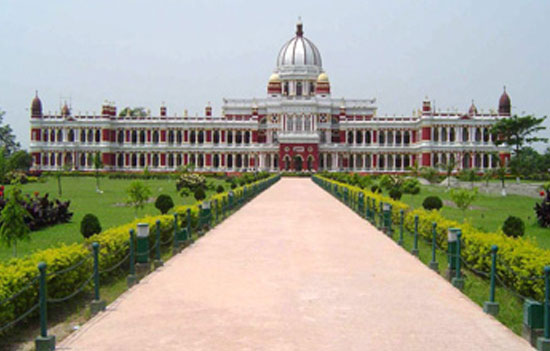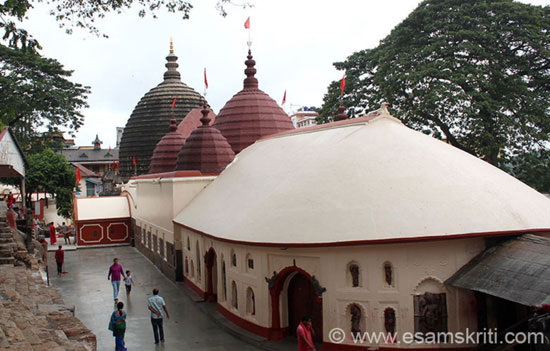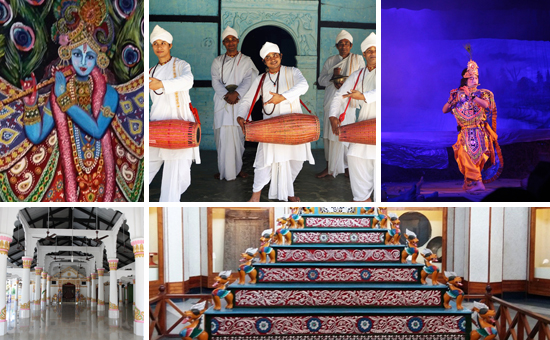- Know about the
life, conquests and achievements of king Naranarayan of the Koch dynasty.
Today Coonch-Bihar is a district of West Bengal. However according to Coonch Bihar site, “The early history of Cooch Behar has to be sought in the history of Assam. In early times the territory was known as Pragjyotisha, which is mentioned
in the Ramayana and the Mahabharata. It appears that the western part of the
original territory of Pragjyotisha came to be known as Kamarupa in later times. Kamarupa remained under the suzerainty of the Guptas and Palas for some time. According to tradition Kamarupa was conquered by Muslim Army in A.D.1498, but they could not keep the kingdom for long. After the expulsion of the Muslim army the Kamta kingdom was engulfed in anarchy. During that period, rise of Koch king started.” 2 See Map - credit https://en.bharatpedia.org/wiki/Koch_dynasty#/media/File:Koch_Bihar_Sketch_Map.jpg) and read on.
 Map
of Coonch-Bihar.
Map
of Coonch-Bihar.
After the invasion
of Kamata kingdom in 1498 by Hussain Shah, the sultan of Bengal, the situation
in kamata kingdom became vulnerable. King Nilambar of Kamata was defeated and never
returned.
Kamata kingdom,
whose kings had successfully resisted tides of Islamic invasion from the times
of king Prithu, was now in the hands of Hussain Shah. His iconoclastic
activities, including destruction of Kamakhya temple (Assam), became
unbearable. Shah placed his son Danyal as governor of Kamata.
These difficult times
gave birth to Viswa Singha, head of Koch tribe, who assembled all baro bhuiyans (local zamindars) under
his banner and killed Daniyal. By 1513 Muslim garrisons were driven out of Kamata.
They were freed of Islamic rule.
This chapter
marked a new beginning in the history of north east that continues to affect
its culture, religion, trade and commerce and socio-political structure. This golden
period reached its peak under the rule of Naranarayan, the greatest monarch of
medieval north east.
Naranarayan was
the son of Viswa Singha. His previous name was Malladev. Viswa sent him and his
brother Sukladhwaja to Kashi to acquire knowledge from Bramhananda Swami. After
the death of Viswa Singha in 1533, Naranarayan ascended the throne after a war
of succession. He inherited a small kingdom from his father, with enemies residing
in all directions. After coronation he turned his attention towards the Ahoms. Initially
his campaign against Ahoms failed, he lost three brothers during this campaign.
After some time he
once again prepared for a campaign against Ahoms. This time he gave command of the
army to his brother Sukladhwaja, known as Chila Rai. He built a road during this
campaign, known as Gohain Kamal Ali. This time he himself marched with the army.
During halts he built a temple of Sri Surya and Durga at Chandikebehar (Mongoldoi).
After a few
confrontations and a major battle (fought on land and water) Chilarai emerged
victorious. Next was a series of naval battles between the two but the result
was the same. Ahoms were repeatedly defeated by Chila Rai. Naranarayan occupied
Garhgaon, the Ahom capital. Ahom king were forced to accept Koch supremacy. The
Koch campaign against Ahoms became successful in the end of 1563.
 Colonial style Coonch-Bhar Palace, Rajbari. Credit coonch.behar.nic.in
Colonial style Coonch-Bhar Palace, Rajbari. Credit coonch.behar.nic.in
After conquering
Ahoms Naranarayan turned his attention to other north eastern states. He reached
the capital of the Hidimba country (Kachhar) at Moibang. The Hidimba king
submitted without a fight. He presented a number of valuables including gold,
silver and elephants and agreed to pay an annual tribute of 1,000 gold mohars,
70, 000 silver mohars and 60 elephants.
Chilarai’s next target was Manipur, the country of the Meithies. Before sending the army, he sent a messenger to the king of Manipur demanding submission and tribute. The king of Manipur agreed to the demands, and immediately presented the Koch king Rs. 20,000 (silver coins), 1,000 gold coins and 40 elephants as the first instalment of tribute. He also agreed to give an annual tribute of 10 Elephants, 300 gold coins and Rs. 20,000 in future.
The advancement of the Koch army under Chilarai continued. They attacked the kingdom of Jayantiya and Chilarai killed the king. On submission, Naranarayan placed the son of the deceased king on the throne who immediately presented 10 horses, 1,000 gold coins, Rs.10,000 (silver coins), 100 ‘Khangra’ (special type of sword, also known as Nakoi-Deo) and others valuables. The
king also agreed to pay an annual Tribute of 70 selected horses, Rs. 10,000
(silver coins) and 300 swords.
Next Chilarai
advanced against Tripura with an army of 40,000. After a fierce battle the Tripuri
king was defeated and killed. The brother of the deceased king, sued for a
peace. He gave Naranarayan presents which included 30 horses, 100 gold coins
and 10,000 silver coins. Naranarayan placed him on the Tripuri throne on the condition
that he would pay an annual tribute of 9,000 gold coins. He stationed a regiment
of soldiers there and constructed a fort near Brahmapur. The fort was named Kochpur. It later got corrupted into as ‘Khaspur’. He also built rampart and excavated tanks.
Rulers of Khairam/
Khyram (Khasi hills) and Dimrua accepted the supremacy of the Koch ruler without
even battle. They paid 30 elephants, 50 horses, 900 gold coins 15,000 silver
coins. The annual tribute was fixed as 7,000 coins.
The Koch army
under the command of Chilarai conquered the whole of Northeast India within 7
years (1562-68).
Note that the Koches did not annex the conquered kingdoms, considering practical problems such as the long distance, communication problem, geographical difficulties and sufficient machineries to do so, but were satisfied with tributes and formal submission of the kings. This realistic and innovative policy could be compared to the policy of Samudragupta’s Southern campaign, in 4th century
AD, who due to similar problems, did not annex the Southern states.
This indicates the
political farsightedness of King Naranarayan who realized the on the ground situation
and adopted a realistic policy.
After conquering the
northeast Naranarayan turned his attention to the west i.e. the Karrani sultan
of Bengal. Destruction of the Kamakhya temple by Karrani had enraged the Koches
who attacked Karrani in 1568. They were defeated and Chilarai was arrested by Karrani.
This was a fatal blow to the Koches. After one year Chilarai was freed by the
Karranis.
The crushing and humiliating defeat of the Koch army at the hands of Sulaiman Karrani led to changes in Naranarayan’s external and internal policies. The traditional policy of ‘aggressive warfare’ ended. He introduced the policy of ‘defensive warfare’ and peaceful co-existence. Thus way he tried to establish cordial relations with the conquered states of the northeast but also with the Mughal Akbar.
Emperor Akbar took
the initiative and addressed a letter to Naranarayan seeking his help and
friendship to fight the Afghans of Bengal and also proposed a part of Bengal
after its subjugation. Naranarayan immediately accepted the proposal of a friendly
alliance and sent letters with a plan to launch an offensive from the eastern
side of Bengal. Accordingly, the forces of both the rulers (King Naranarayan
and emperor Akbar) then invaded Bengal from both the sides i.e. the Koches from
north-eastern side and the Mughal from western side, and defeated the Padsha,
occupied Bengal and then divided it between themselves. The relations between king Naranarayan and Akbar were very cordial. The king’s friendship with Akbar was not as a subordinate ally.
During this
campaign Chilarai, brother and general of Nara Narayana died due to small pox.
This was a big blow to the Koch kingdom. King Naranarayan now adopted defensive
policies. He subjugated the revolts of 1577, 1580 and re- established Koch
supremacy.
The kingdom
established by his father Viswa Singha and extended by him with the help of his
illustrious brother general Chilarai, reached its zenith in the 7th decade of
the 16th century. At his peak Naranarayan
established political control directly or indirectly, over the whole Northeast up
to the Burma border and from the North-eastern part of Bengal up to the Tibet
border. On the south and the West, he extended control up to Ghoraghat
and Mithila or Tirhut border respectively.
Apart from his
military campaigns, he was also man of art, culture and peace. His achievements
in the fields of socio economic space, cultural transition and development of languages, literature and arts continue to have an impact across the northeast. He was the forerunner of societal development and assimilation, a strong believer of stable economy, great patron of learning of Sanskrit, Bengali and local Kamatupuri language and literature. He was the prime mover of all intra- human developments and assimilations.
 Kamakhya Devi Mandir.
Kamakhya Devi Mandir.
He rebuilt
Kamakhya Devi temple and also built the Hayagriva Madhava, Baneswara Siva and Madanmohana
temples. He started the worshipping of Durga with ten arms. This form of
worship became so popular that the Ahom king got artisans from the Koch kingdom
to build a Durga temple. He constructed many roads, excavated tanks and canals
during his military campaigns.
 Mekhela Chador sold at Sualkuchi. (near Guwahati)
Mekhela Chador sold at Sualkuchi. (near Guwahati)
The lower strata
of the society was satisfied during the rule of Naranarayan. His officers never
interfered in personal matters of peasants, artisans and others. The taxation
policy was flexible. He minted coins in his name. These were known as Narayani
Coins or Narayani tanka. His period witnessed growth and acceleration in
industries, crafts, agriculture, trade and commerce. The growth of the cloth
industry, esp. silk and cotton was remarkable during his era. Sualkuchi (in
Assam) and Narayanpur emerged as major trade centres.
He was a learned
man in Sanskrit and showed great interest in literal activities. Sanskrit
learning was greatly extended throughout the kingdom. Sanskrit grammar Prayoga Ratnamala was written under his
patronisation. The Ramayana, Mahabharata and 18 Puranas were translated during
his reign.
The Koch King
Naranarayan not only encouraged the cultivation of religious literature, but
also patronized the development of secular subjects like biography, arithmetic,
astrology and medical science etc. Bakul Kayastha, a court writer of king
Naranarayan, wrote the Kitavat manjuri,
a book on arithmetic, land surveying and
Bookkeeping.
Another scholar wrote a book on astronomy Sadhyakhanda
on Jyotish. Churamani wrote his work Jyotis Churamani on arithmetic, astrology
and Mensuration (means measurements) in about 1560 A.D. He himself composed a Sanskrit dictionary named Malladev Abhidhan.
 Satra culture Assam.
Satra culture Assam.
During his reign,
Vaishnavism and Vaishnavite literature witnessed period of rejuvenation. He patronised
and gave protection to Vaishnavite Guru Sankardeva whose Vaishnavite doctrines
were well received by society. Along with temples, he built many Vaishnavite
Satras throughout his kingdom. People called him Dharma Raja due to his overall rule. Even Akbarnama praises Nara
Narayana as follows
“King Naranarayan was full of wisdom and adorned with highest qualities.”
Naranarayan died in
1587 after ruling for 50 years.
He was greatest
ever monarch of north east India. I wish to conclude with the Kamakhya temple
inscription i.e. attributed to him-
“Glory to the king Maliadeva , who virtue of his mercy , is kind to the people , whose archery is like Arjun , and in charity like Dadhichi and Kama;-versed in many Sastras ; his character is excellent ; in beauty he is as bright as Kandarpa, he is a worshipper of Kamakhya.”
Sources
and References
1. History of Koch
Kingdom (1515-1615) by D. Nath.
2. King Nara
Narayana and his times by B. Parimal.
3. Rajopakhanya,
the Koch chronicle.
4. Baharistan E
Ghyabi Volume 1.
5. History of Cooch
Behar by S C Ghosh.
Also
read
1. About
Coonch Bihar Princely State
2. Royal History of
Coonch Bihar
3. Satra
Culture of Assam
To read all
articles by author